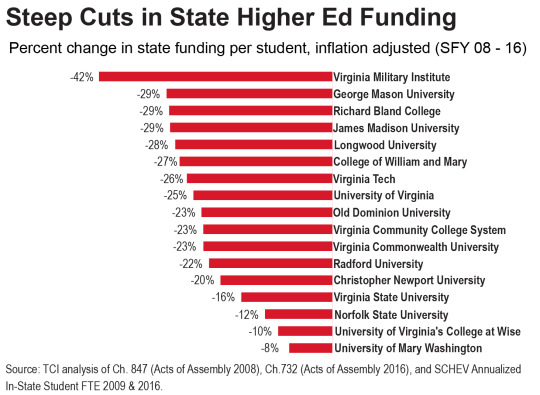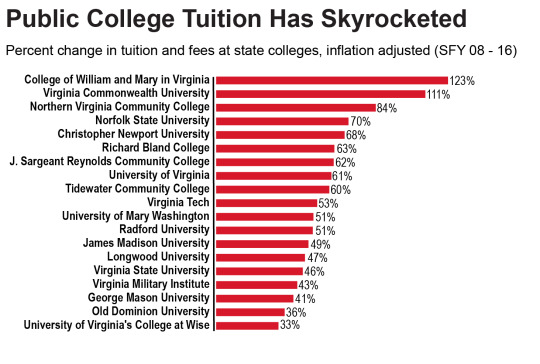July 22, 2016
The Soaring Cost of Virginia’s Public Universities
State funding cuts for higher education have increased tuition and mandatory fees at Virginia’s public universities, making college less affordable, and jeopardizing the ability of many students to receive the college education that is key to their long-term financial success and essential to growing Virginia’s economy.
Per pupil state support for higher education in Virginia is down 22.5 percent between fiscal years 2008 and 2016, when adjusted for inflation. This puts Virginia in the top third of states in the country with the most severe per-student state investment. This continued reduction of state support across the country is not only driving up tuition, but also eroding educational quality by reducing faculty and course offerings.

All public two-year and four-year universities in Virginia have been impacted by state funding cuts. Alarmingly, Virginia’s two-year colleges and 10 out of 15 of Virginia’s four-year institutions have seen a reduction of more than 20 percent per pupil spending from the state, when adjusted for inflation. The Virginia Military Institute and George Mason University have seen the largest cuts – 42 percent and 29 percent respectively. The cuts had a similar impact on two-year colleges. Virginia’s community colleges and Richard Bland College, a two-year junior college, have seen cuts of 23 percent and 29 percent per pupil respectively.
As a result, these schools have increased tuition and mandatory fees, placing a greater burden on students and their families. Between fiscal years 2008 and 2016, the change in tuition and mandatory fees skyrocketed. Virginia’s two-year institutions and 13 out of 15 of Virginia’s four-year public institutions have seen percent changes in tuition and educational fees of 40 percent or more, after adjusting for inflation. The College of William and Mary and Virginia Commonwealth University have seen the largest percent changes, 123 percent and 111 percent respectively. In addition, Northern Virginia Community College, J. Sargeant Reynolds Community College, and Tidewater Community College, the largest public community colleges within the Virginia Community College System, had percent changes of 84 percent, 62 percent, and 60 percent, respectively.

Drastic and unpredictable changes to tuition and mandatory fees make it difficult for students and their families to financially plan for college. This problem disproportionately impacts students and families facing financial difficulties, including many students of color, and it deters many from enrolling in college or completing their degree.
Making matters worse, these increases come at a time when Virginians have not seen a substantial increase in their wages since 2008. Median hourly wages for Virginians remained relatively flat, only increasing 2.8 percent through 2015 after adjusting for inflation. As a result, in recent years there has been an increase in student loans and other forms of financial aid to help students and their families pay for higher education.
In the newly adopted budget, lawmakers made some progress toward restoring cuts. Per pupil support from the state will be up 5 percent in 2018 from 2016, but it remains well below pre-recession levels, when adjusted for inflation.
Making college more affordable is a key goal of Virginia’s Plan for Higher Education, a plan developed by the State Council of Higher Education to identify trends that the commonwealth must address if it is to continue to prosper and succeed.
However, the diminished financial support from the state and the continued rise in tuition and fees at public universities are pushing that goal out of reach. By the year 2020, 67 percent of all jobs in Virginia will require some level of post-secondary education. The future economic prosperity of Virginia relies on an educated and skilled workforce. The recently adopted budget takes a step in the right direction, however still greater investment needs to be made to support Virginia’s students.
Category:
Education
